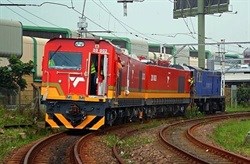
Top stories




These days, as Transnet posts massive profits and tonnages continue to rise, it would be easy to say yes.
It has not always been this way, however. Transnet and its bloated, inefficient forebears have long been easy targets for being more about sheltered employment than providing a freight transport service that customers wanted. When road transport was deregulated in 1985, customers fled to trucks en masse.
The railways bled money like a stuck pig. In 1995, it reported a R21-million loss.
It was a drain on the public purse and if the government had been watching events in Canada, where the state had just pulled off a wildly successful turnaround and IPO of Canadian National - that country's version of Transnet on a grand scale - perhaps Transnet would now also be a private railway.
When Gama joined Transnet in 1994, the company was on the ropes.
Its general freight business had evaporated and many of its loss-making branch lines had been closed - and remain so today - as it consolidated its network.
Against that backdrop, the rail division's turnaround is impressive, especially in the light of what Gama calls "delinquent underinvestment" in the late '90s as Transnet followed the advice of consultants to shrink the business.
"The consultants said [Transnet] must no longer invest in the general freight business, park some of the locomotives and that it would make money by shrinking itself into greatness," Gama said. "In a network business, that is not the correct strategy."
Instead, Transnet began investing heavily in its business, culminating in the current market demand strategy, in terms of which it will spend R312-billion on locomotives, track, port capacity and other infrastructure by 2020.
Gama's appointment to the top job at the rail division in 2011 was not without controversy. He had previously held the post from 2005 until he was dismissed in 2010 following a breach of governance requirements relating to two procurement contracts.
He was later reinstated after a review of his dismissal.
During his first period in the hot seat, he had also been blamed by coal miners for declining coal exports.
Last year, however, Transnet Freight Rail reported profits of R5.1-billion and carried 210.4 million tons of freight.
While the effects of previous Transnet boss Maria Ramos's financial discipline and the commodities supercycle have certainly helped, at least some of the credit must go to Gama's leadership.
"I have demonstrated a track record in turning around sleeping giants such as this one," he said.
That record earned him the Black Business Quarterly's public sector visionary award this year for his "astute business acumen and entrepreneurial spirit".
The comparison with Canadian National is apt.
Transnet's path to its current riches - the group reported revenue of R30.3-billion for the six months to September - was almost a carbon copy of the measures that super-bureaucrat Paul Tellier applied to turn Canadian National from what the press called "the national nightmare" into one of the most successful railways in the world.
Like Gama, Tellier had to deal with criticism that he was not a railwayman. Tellier retorted that railwaymen had created the mess in the first place; what was needed was a leader.
"I wasn't concerned about what I knew about railways," said Gama. "I needed to understand the business model and how 38000 people could work together."
Gama has overseen the restructuring of the rail arm into seven business units, which cover all its traffic, from ore and coal to cars and containers.
The business units compete with one another for resources such as locomotives, in short supply while the company waits for engines ordered in this year's "1064-locomotive deal" to begin rolling out of the works.
"We designed our business units to create hunger and internal competition between the general managers of those units," Gama said.
"We have a use-it-or-lose-it philosophy where we ring-fence the locomotives.
"If you can't optimise your locomotives and there's another business unit next door that says 'We've got cargo', we move the locomotives."
This more flexible approach to doing business would have been unlikely in the Transnet of old.
It is not all sunshine and roses, however. Gama said the cable theft situation was "dire" and truck competition remained intense.
Transnet plans to test two intermodal technologies next year but whether these will win the battle against trucks remains to be seen.
Transnet has also not yet presented a clear strategy for its closed or noncore rail routes.
Sagging commodity prices are also a concern as the supercycle runs out of steam.
The ore price is at $80 (R880) per ton and coal - one of Transnet's big earners - hovers at $65 per ton.
"When coal was at $125 per ton and you said to people at the time it would go to $65, people would say you're mad," Gama said. "We hope it's beginning to bottom out."
It's an ill wind that blows nobody any good and in this case it may be the tsunami at Fukushima in Japan in 2011 that will have a spin-off for Transnet.
"That made some countries in Europe say coal-fired power stations are much safer, that they don't want an overconcentration on nuclear power," said Gama. "As long as the pollution can be mitigated, the demand for coal will continue to rise."
Source: Business Times

For more than two decades, I-Net Bridge has been one of South Africa’s preferred electronic providers of innovative solutions, data of the highest calibre, reliable platforms and excellent supporting systems. Our products include workstations, web applications and data feeds packaged with in-depth news and powerful analytical tools empowering clients to make meaningful decisions.
We pride ourselves on our wide variety of in-house skills, encompassing multiple platforms and applications. These skills enable us to not only function as a first class facility, but also design, implement and support all our client needs at a level that confirms I-Net Bridge a leader in its field.
Go to: http://www.inet.co.za